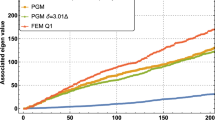Abstract
Based on the fact that a static problem has an equivalent wave speed of infinity and a dynamic problem has a wave speed of finite value, an effective loading algorithm associated with the explicit dynamic relaxation method was presented to produce meaningful numerical solutions for static problems. The central part of the explicit dynamic relaxation method is to turn a time-independent static problem into an artificial time-dependent dynamic problem. The related numerical testing results demonstrate that: (1) the proposed effective loading algorithm is capable of enabling an applied load in a static problem to be propagated throughout the whole system within a given loading increment, so that the time-independent solution of the static problem can be obtained; (2) the proposed effective loading algorithm can be straightforwardly applied to the particle simulation method for solving a wide range of static problems.
Similar content being viewed by others
References
PICA A, HINTON E. Transient and pseudo-transient analysis of Mindlin plates [J]. International Journal for Numerical Methods in Engineering, 1980, 15(2): 189–208.
KOBAYASHI H, TURVEY G J. On the application of a limiting process to the dynamic relaxation analysis of circular membranes, circular plates and spherical shells [J]. Computers and Structures, 1993, 48(6): 1107–1116.
KADKHODAYAN M, ZHANG L C. A consistent DXDR method for elastic-plastic problems [J]. International Journal for Numerical Methods in Engineering, 1995, 38(14): 2413–2431.
CUNDALL P A, STRACK O D L. A discrete numerical model for granular assemblies [J]. Geotechnique, 1979, 29(1): 47–65.
CUNDALL P A. A discontinuous future for numerical modelling in geomechanics? [J]. Proceedings of the Institution of Civil Engineers: Geotechnical Engineering, 2001, 149(1): 41–47.
KLERCK P A, SELLERS E J, OWEN D R J. Discrete fracture in quasi-brittle materials under compressive and tensile stress states [J]. Computer Methods in Applied Mechanics and Engineering, 2004, 193(27/29): 3035–3056.
OWEN D R J, FENG Y T, DE-SOUZA-NETO E A, COTTRELL M G, WANG F, ANDRADE-PIRES F M, YU J. The modeling of multi-fracturing solids and particular media [J]. International Journal for Numerical Methods in Engineering, 2004, 60(1): 317–339.
POTYONDY D O, CUNDALL P A. A bonded-particle model for rock [J]. International Journal of Rock Mechanics and Mining Sciences, 2004, 41(18): 1329–1364.
ZHAO C, NISHIYAMA T, MURAKAMI A. Numerical modeling of spontaneous crack generation in brittle materials using the particle simulation method [J]. Engineering Computations, 2006, 23(5/6):566–584.
ZHAO C, HOBBS B E, ORD A, HORNBY P, PENG S, LIU L. Particle simulation of spontaneous crack generation problems in large-scale quasi-static systems [J]. International Journal for Numerical Methods in Engineering, 2007, 69(11): 2302–2329.
ZHAO C, HOBBS B E, ORD A, PENG S. Particle simulation of spontaneous crack generation associated with the laccolithic type of magma intrusion processes [J]. International Journal for Numerical Methods in Engineering, 2008, 75(10): 1172–1193.
SALTZER S D, POLLARD D D. Distinct element modeling of structures formed in sedimentary overburden by extensional reactivation of basement normal faults [J]. Tectonics, 1992, 11(1):165–174.
BURBIDGE D R, BRAUN J. Numerical models of the evolution of accretionary wedges and fold-and-thrust belts using the distinct-element method [J]. Geophysical Journal International, 2002, 148(3): 542–561.
ITASCA C G. Fast Lagrangian analysis of continua (FLAC) [Z]. Minneapolis: Minnesota, 1995.
ITASCA C G. Particle flow code in two dimensions (PFC2D) [Z]. Minneapolis: Minnesota, 1999.
Author information
Authors and Affiliations
Corresponding author
Additional information
Foundation item: Projects(10872219; 10672190) supported by the National Natural Science Foundation of China
Rights and permissions
About this article
Cite this article
Zhao, Cb., Peng, Sl., Liu, Lm. et al. Effective loading algorithm associated with explicit dynamic relaxation method for simulating static problems. J. Cent. South Univ. Technol. 16, 125–130 (2009). https://doi.org/10.1007/s11771-009-0021-7
Received:
Accepted:
Published:
Issue Date:
DOI: https://doi.org/10.1007/s11771-009-0021-7




